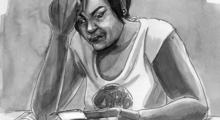Seeing through an abuser’s performances of “love” gives victims renewed power
- By Lisa Aronson Fontes, PhD with Laura Marjorie Miller

Abusive and controlling partners often use “loving” acts to manipulate their victims. When intimidation, isolation, and even physical abuse no longer seem to be working, the abuser pulls out the wedding albums or acts charming and contrite to win the abused partner back. One former abuser, for instance, described how he regularly sent flower arrangements to his girlfriend’s workplace so her co-workers would tell her how lucky she was to be with him.
Some people call these acts of love “the honeymoon” or “making-up” phase of a “cycle of violence.” We prefer to think of these as bait leading to a trap. Occasional acts of kindness are a grooming strategy to retain control and make a partner stay in the relationship. An abuser may intersperse loving acts with angry outbursts, sexual coercion and manipulation, producing a kind of emotional whiplash in his partner.
The victim may welcome the candy, kisses, and compliments, believing these are signs that the abusive partner is changing. However, the kinder periods are most likely ploys to make the abused partner stay. The abuser chooses to behave kindly when they believe that expressing “love” is the best strategy for retaining control. These periods of kindness work to keep the partner hopeful and coming back for more.
Make a Donation
It is easy to ignore this message. Please don’t. We and the millions of people who use this non-profit website to prevent and escape domestic violence rely on your donations. A gift of $5 helps 25 people, $20 helps 100 people and $100 helps 500 people. Please help keep this valuable resource online.
- $5
- $20
- $100
Laura says that she learned to stop “falling for” her former partner’s acts of love by thinking about them as bait. She saw him as a forest trapper, setting out an alluring object that was hard to resist, so he could keep her where he wanted her. She began to identify the overtly negative words and actions as “poison,” and the “loving” acts as bait. This made it easier to dismiss his affectionate attempts at reconciliation—she knew their true intention: to keep her trapped.
“I realized that no matter what the lure looked like, it was either bait or poison: bait if it was sweet and engaging, or poison if it was him lashing out in an attempt to lodge some self-doubt in my mind as he had often done before. Once, he could create nostalgia about the time we were together, and I would decide to take him back. After I considered it bait, these acts lost their power.”
Unless people have had experience with a coercively controlling person, they may not understand that communication can function this way. They will assume that the abuser’s “loving” acts or words are like anyone else’s attempts to convey genuine affection. But “sweet,” coercive control communication is sugary poison. Picture a hunter placing the meat in a trap, or an angler using a worm to reel in the catch.
Sign up for emails
Receive new and helpful articles weekly. Sign up here.
Thinking about poison and bait can set free people in coercive control relationships. Be cautious, like an animal in the forest. You do not need to eat from that trap. Self-preservation = self-love.
Lisa Aronson Fontes, Ph.D., is a senior lecturer at the University of Massachusetts, Amherst, and the author of Invisible Chains: Overcoming Coercive Control in Your Intimate Relationship.
Related Articles
-
Possessiveness: The Precursor to Power and Control
-
It’s Not Love, It’s Love Bombing
-
What is Coercive Control?
-
More About Coercive Control
-
How to Recognize Emotional Abuse
-
Normal Jealousy or the Start of Abuse?
Content retrieved from: https://www.domesticshelters.org/articles/identifying-abuse/resisting-control-when-it-s-disguised-as-love.






